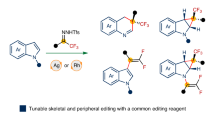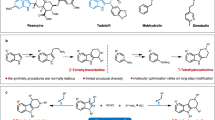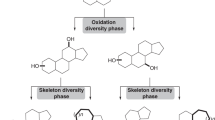Abstract
A compound’s overall contour impacts its ability to elicit biological response, rendering access to distinctly shaped molecules desirable. A natural product’s framework can be modified, but only if it is abundant and contains suitably modifiable functional groups. Here we introduce a programmable strategy for concise synthesis of precisely altered scaffolds of scarce bridged polycyclic alkaloids. Central to our approach is a scalable catalytic multi-component process that delivers diastereo- and enantiomerically enriched tertiary homoallylic alcohols bearing differentiable alkenyl moieties. We used one product to launch progressively divergent syntheses of a naturally occurring alkaloid and its precisely expanded, contracted and/or distorted framework analogues (average number of steps/scaffold of seven). In vitro testing showed that a skeleton expanded by one methylene in two regions is cytotoxic against four types of cancer cell line. Mechanistic and computational studies offer an account for several unanticipated selectivity trends.

This is a preview of subscription content, access via your institution
Access options
Access Nature and 54 other Nature Portfolio journals
Get Nature+, our best-value online-access subscription
$29.99 / 30 days
cancel any time
Subscribe to this journal
Receive 12 print issues and online access
$259.00 per year
only $21.58 per issue
Buy this article
- Purchase on Springer Link
- Instant access to full article PDF
Prices may be subject to local taxes which are calculated during checkout






Similar content being viewed by others
Data availability
All data in support of the findings of this study are available within the article and its Supplementary Information. Crystallographic data for the structures reported in this article have been deposited at the Cambridge Crystallographic Data Centre, under deposition numbers CCDC 2237819 (7b) and 1874716 (8). Source data are provided with this paper.
References
Campos, K. R. et al. The importance of synthetic chemistry in the pharmaceutical industry. Science 363, eaat0805 (2019).
Grigalunas, M., Burhop, A., Christoforow, A. & Waldmann, H. Pseudo-natural products and natural product-inspired methods in chemical biology and drug discovery. Curr. Opin. Chem. Biol. 56, 111–118 (2020).
Guillemard, L., Kaplaneris, N., Ackermann, L. & Johansson, M. J. Late-stage C–H functionalization offers new opportunities in drug discovery. Nat. Rev. Chem. 5, 522–545 (2021).
Huigens, R. W. III et al. A ring-distortion strategy to construct stereochemically complex and structurally diverse compounds from natural products. Nat. Chem. 5, 195–202 (2013).
Jurczyk, J. et al. Single-atom logic for heterocycle editing. Nat. Synth. 1, 352–364 (2022).
McLeod, M. C. et al. Probing chemical space with alkaloid-inspired libraries. Nat. Chem. 6, 133–140 (2014).
Fokas, D., Yu, L. & Baldino, C. M. Strategies for the synthesis of indole alkaloid-based screening libraries for drug discovery. Mol. Divers. 9, 81–89 (2005).
Shearer, J., Castro, J. L., Lawson, A. D. G., McCoss, M. & Taylor, R. D. Rings in clinical trials and drugs: present and future. J. Med. Chem. 65, 8699–8712 (2022).
Noguchi, Y. et al. Synthesis and stereochemical determination of an antiparasitic pseudo-aminal type monoterpene indole alkaloid. J. Nat. Med. 70, 302–317 (2016).
Arens, H., Borbe, H. O., Ulbrich, B. & Stöckigt, J. Detection of pericine, a new CNS-active indole alkaloid from Picralima nitida cell suspension culture by opiate receptor binding studies. J. Med. Plant. Res. 46, 210–214 (1982).
Bonjoch, J., Solé, D., GarcÍa-Rubio, S. & Bosch, J. A general synthetic entry to strychnos alkaloids of the curan type via a common 3a-(2-nitrophenyl)hexahydroindol-4-one intermediate. Total syntheses of (±)19,20-dihydroakuammicine, (±)-norfluorocurarine, (±)-echitamidine, and (±)-20-epilochneridine. J. Am. Chem. Soc. 119, 7230–7240 (1997).
Michel, S., Tillequin, F. & Koch, M. Brafouédine et isobrafouédine: nouveux alcoïdes indoliques mineurs de strychnos dinklagei. J. Nat. Prod. 49, 452–455 (1986).
Lima, J. A. et al. Geissoschizoline, a promising alkaloid for Alzheimer’s disease: inhibition of human cholinesterases, anti-inflammatory effects and molecular docking. Bioorg. Chem. 104, 104215 (2020).
Arita, T. et al. Discovery of conolidine derivative DS39201083 as a potent novel analgesic without mu opioid agonist activity. Bioorg. Med. Chem. Lett. 29, 1938–1942 (2019).
Jhoti, H., Williams, G., Rees, D. C. & Murray, C. W. The ‘rule of three’ for fragment-based drug discovery: where are we now? Nat. Rev. Drug Discov. 12, 644 (2013).
Hirose, T. et al. Structure determination and total synthesis of (+)‐16‐hydroxy‐16,22‐dihydroapparicine. Chem. Eur. J. 19, 10741–10750 (2013).
Schreiber, S. L. Target-oriented and diversity-oriented organic synthesis in drug discovery. Science 287, 1964–1969 (2000).
Galloway, W. R. J. D., Isidro-Llobet, A. & Spring, D. R. Diversity-oriented synthesis as a tool for the discovery of novel biologically active small molecules. Nat. Commun. 1, 80 (2010).
Kim, J., Kim, H. & Park, S. B. Privileged structures: efficient chemical ‘navigators’ toward unexplored biologically relevant chemical spaces. J. Am. Chem. Soc. 136, 14629–14638 (2014).
Wilson, R. M. & Danishefsky, S. J. Small molecule natural products in the discovery of therapeutic agents: the synthesis connection. J. Org. Chem. 71, 8329–8351 (2006).
Garcia-Castro, M., Zimmermann, S., Sankar, M. G. & Kumar, K. Scaffold diversity synthesis and its application in probe and drug discovery. Angew. Chem. Int. Ed. 55, 7586–7605 (2016).
Lusi, R. F., Perea, M. A. & Sarpong, R. C–C bond cleavage of α-pinene derivatives prepared from carvone as a general strategy for complex molecule synthesis. Acc. Chem. Res. 55, 746–758 (2022).
Liu, Y.-L. & Lin, X.-T. Recent advances in catalytic asymmetric synthesis of tertiary alcohols via nucleophilic addition to ketones. Adv. Synth. Catal. 361, 876–918 (2019).
Meng, F., Jang, H., Jung, B. & Hoveyda, A. H. Cu-catalyzed chemoselective preparation of 2-(pinacolato)boron-substituted allylcopper complexes and their in situ site-, diastereo- and enantioselective additions to aldehydes and ketones. Angew. Chem. Int. Ed. 52, 5046–5051 (2013).
Tsai, E. Y., Liu, R. Y., Yang, Y. & Buchwald, S. L. A regio- and enantioselective CuH-catalyzed ketone allylation with terminal allenes. J. Am. Chem. Soc. 140, 2007–2011 (2018).
Yang, Y., Perry, I. B., Lu, G., Liu, P. & Buchwald, S. L. Copper-catalyzed asymmetric addition of olefin-derived nucleophiles to ketones. Science 353, 144–150 (2016).
Li, C. et al. CuH-catalyzed enantioselective ketone allylation with 1,3-dienes: scope, mechanism, and applications. J. Am. Chem. Soc. 141, 5062–5070 (2019).
Feng, J.-J., Xu, Y. & Oestreich, M. Ligand-controlled diastereodivergent, enantio- and regioselective copper-catalyzed hydroxyalkylboration of 1,3-dienes with ketones. Chem. Sci. 10, 9679–9683 (2019).
Fu, B. et al. Copper-catalyzed asymmetric reductive allylation of ketones with 1,3-dienes. Org. Lett. 21, 3576–3580 (2019).
Huang, Y., Torker, S., Li, X., del Pozo, J. & Hoveyda, A. H. Racemic vinylallenes in catalytic enantioselective multicomponent processes: rapid generation of complexity through 1,6‐conjugate additions. Angew. Chem. Int. Ed. 58, 2685–2691 (2019).
Matteson, D. S. & Sadhu, K. M. Boronic ester homologation with 99% chiral selectivity and its use in syntheses of the insect pheromones (3S,4S)-4-methyl-3-heptanol and exo-brevicomin. J. Am. Chem. Soc. 105, 2077–2078 (1983).
Hoveyda, A. H., Hird, A. W. & Kacprzynski, M. A. Small peptides as ligands for catalytic asymmetric alkylations of olefins. Rational design of catalysts or of searches that lead to them? Chem. Commun. 21, 1779–1785 (2004).
Blakemore, P. R. & Burge, M. S. Iterative stereospecific reagent-controlled homologation of pinacol boronates by enantioenriched α-chloroalkyllithium reagents. J. Am. Chem. Soc. 129, 3068–3069 (2007).
Strom, A. E. & Hartwig, J. F. One-pot anti-Markovnikov hydroamination of unactivated alkenes by hydrozirconation and amination. J. Org. Chem. 78, 8909–8914 (2013).
Bernoud, E. et al. Recent advances in metal free-and late transition metal-catalysed hydroamination of unactivated alkenes. Catal. Sci. Technol. 5, 2017–2037 (2015).
Huang, L. et al. Late transition metal-catalyzed hydroamination and hydroamidation. Chem. Rev. 115, 2596–2697 (2015).
Takaya, H., Yamakawa, M. & Mashima, K. Synthesis and characterization of 2-[di(cyclopentadienyl)zircona]-1-oxacyclopentanes. X-ray crystal structure of [(η-C5H5)2ZrOCH2CH2CHMe]2. J. Chem. Soc. Chem. Commun. 1283–1284 (1983).
Liu, X. & Ready, J. M. Directed hydrozirconation of homopropargylic alcohols. Tetrahedron 64, 6955–6960 (2008).
Gritsch, P. J., Leitner, C., Pfaffenbach, M. & Gaich, T. The Witkop cyclization: a photoinduced C–H activation of the indole system. Angew. Chem. Int. Ed. 53, 1208–1217 (2014).
Joule, J. A. et al. Alkaloid studies. Part XLVIII. The structure of apparicine, a novel aspidosperma alkaloid. J. Chem. Soc. 87, 4773–4780 (1965).
Moffat, J. G., Vincent, F., Lee, J. A., Eder, J. & Prunotto, M. Opportunities and challenges in phenotypic drug discovery: an industry perspective. Nat. Rev. Drug Discov. 16, 531–543 (2017).
Ghanbarian, M., Afgar, A., Yadegarazari, R., Najafi, R. & Teimoori-Tolabi, L. Through oxaliplatin resistance induction in colorectal cancer cells, increasing ABCB1 level accompanies decreasing level of miR-302c-5p, miR-3664-5p and miR-129-5p. Biomed. Pharmacol. 108, 1070–1080 (2018).
Kobayashi, J. et al. Subincanadines A–C, novel quaternary indole alkaloids from Aspidosperma subincanum. J. Org. Chem. 67, 6449–6455 (2002).
Fujii, A. et al. Experimental and theoretical determination of the accurate CH/π interaction energies in benzene–alkane clusters: correlation between interaction energy and polarizability. Phys. Chem. Chem. Phys. 13, 14131–14141 (2011).
Wagner, J. P. & Schreiner, P. R. London dispersion in molecular chemistry—reconsidering steric effects. Angew. Chem. Int. Ed. 54, 12274–12296 (2015).
Burns et al. Assembly-line synthesis of organic molecules with tailored shapes. Nature 513, 183–188 (2014).
Ji, N.-Y. et al. Diterpenes, sesquiterpenes, and a C15-acetogenin from the marine red alga Laurencia mariannenins. J. Nat. Prod. 70, 1901–1905 (2007).
Zhang, W.-H., Williams, I. D. & Che, C.-T. Chabrolols A, B, and C, three new norditerpenes from the soft coral Nephthea charbroli. Tetrahedron Lett. 42, 4681–4685 (2001).
Sin, N. et al. The anti-angiogenic agent fumagillin covalently binds and inhibits the methionine aminopeptidase, MetAP-2. Proc. Natl Acad. Sci. USA 94, 6099–6103 (1997).
Lu, J., Chong, C. R., Hu, X. & Liu, J. O. Fumarranol, a rearranged fumagillin analogue that inhibits angiogenesis in vivo. J. Med. Chem. 49, 5645–5648 (2006).
Acknowledgements
The methodological aspects of this work were funded by the NIH (grant R35 GM-130395 to A.H.H.). Support for applications to synthesis of NP and the corresponding analogues was provided by the CNRS, the ANR (project PRACTACAL to A.H.H.), the Jean-Marie Lehn Foundation for Chemistry Research (University of Strasbourg, to A.H.H.) and the Circle Gutenberg Foundation (2020 Chair for A.H.H.). Additional support was provided by the University of Illinois (for P.J.H.) and the NIH (grant R35 GM-128779 to P.L.). We thank the Shanghai Institute of Organic Chemistry and Solvay, S.A. for a postdoctoral and a predoctoral fellowship to Y.H. and X.L., respectively. In vitro testing was performed at the University of Illinois, Urbana-Champain. DFT and PMI studies were carried out at the Center for Research Computing at the University of Pittsburgh, Bridges 2 supercomputer at the San Diego Supercomputer Center through allocation TG-CHE140139 from the Advanced Cyberinfrastructure Ecosystem: Services and Support (ACCESS) programme, funded by NSF grants. We are grateful to F. Romiti, M. Formica, S. Ng, S. Xu and A. Nikbakht for helpful discussions.
Author information
Authors and Affiliations
Contributions
A.H.H., X.L. and Y.H. designed and developed the catalytic multi-component method and prepared the natural products and skeletal analogues. P.J.H., E.J.T. and A.J.S. performed the in vitro testing. P.L. and B.K.M. designed and performed the DFT studies. A.H.H. conceived the project, directed the investigations and wrote the paper, and the other authors provided editorial advice.
Corresponding authors
Ethics declarations
Competing interests
The authors declare no competing interests.
Peer review
Peer review information
Nature Chemistry thanks Kevin Kou and the other, anonymous, reviewer(s) for their contribution to the peer review of this work.
Additional information
Publisher’s note Springer Nature remains neutral with regard to jurisdictional claims in published maps and institutional affiliations.
Supplementary information
Supplementary Information
Supplementary Figs. 1–12 and Tables 1–8.
Supplementary Data 1
Crystallographic data for compound 7b; CCDC reference 2237819.
Supplementary Data 2
Crystallographic data for compound 7b; CCDC reference 1874716.
Supplementary Data 3
The xyz coordinates of computed structures.
Source data
Source Data Fig. 5
Statistical source data for Fig. 5f.
Rights and permissions
Springer Nature or its licensor (e.g. a society or other partner) holds exclusive rights to this article under a publishing agreement with the author(s) or other rightsholder(s); author self-archiving of the accepted manuscript version of this article is solely governed by the terms of such publishing agreement and applicable law.
About this article
Cite this article
Huang, Y., Li, X., Mai, B.K. et al. A catalytic process enables efficient and programmable access to precisely altered indole alkaloid scaffolds. Nat. Chem. (2024). https://doi.org/10.1038/s41557-024-01455-7
Received:
Accepted:
Published:
DOI: https://doi.org/10.1038/s41557-024-01455-7



